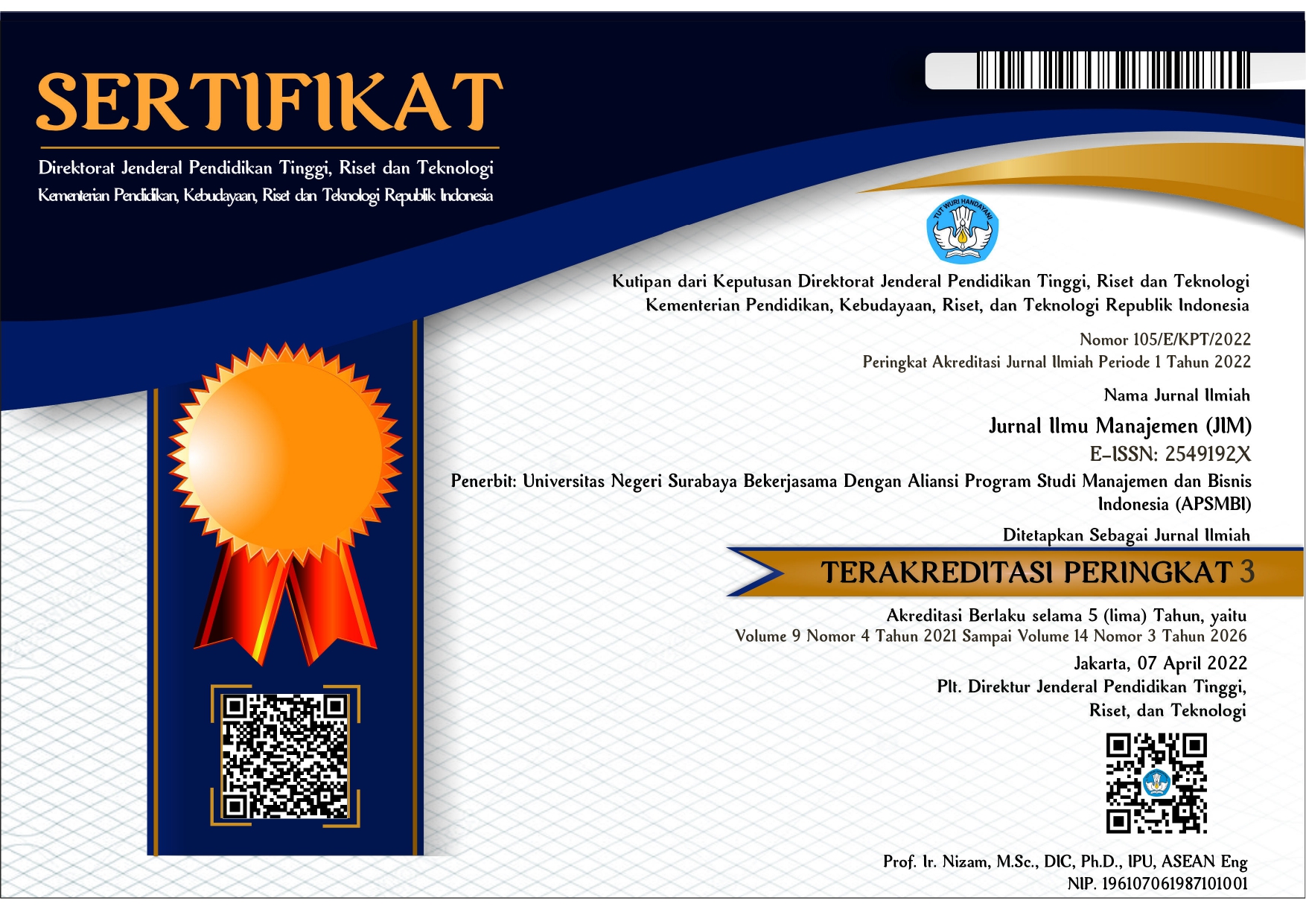Pengaruh social system dan technical system terhadap purchase intention: peran engagement, desire to postpone closure, dan product relevance pada short format video di Tiktok
DOI:
https://doi.org/10.26740/jim.v13n1.p208-227Keywords:
desire to postpone closure, engagement, purchase intention, social commerce, social mediaAbstract
This study analyses the influence of social and technical systems on purchase intention by examining the role of engagement, desire to postpone closure, and product relevance on purchase intention on the TikTok social commerce platform. TikTok is one of the leading platforms with more than 1 billion users. It combines social media and e-commerce, allowing users to search for and buy products through short video formats. The research method used is a quantitative approach with an explanatory research design involving 167 respondents selected using purposive sampling. The results of this study indicate that entertainment and social interaction have a positive and significant effect on engagement, product visibility and recommendation have a positive and significant effect on desire to postpone closure, and recommendation also has a positive and significant effect on product relevance. While entertainment and social interaction do not significantly affect desire to postpone closure. however, engagement and desire to postpone closure as mediating variables significantly affect purchase intention. While product relevance as a mediating variable does not significantly affect purchase intention, product relevance can mediate the influence of the recommendation algorithm on desire to postpone closure. This study provides valuable insights for marketers and advertisers in designing effective marketing strategies on the TikTok platform.
References
Adamopoulos, P., Ghose, A., & Todri, V. (2018). The impact of user personality traits on word of mouth: Text-mining social media platforms. Information Systems Research, 29(3), 612–640. https://doi.org/10.1287/isre.2017.0768
Agustina, D. (2017). Fitur social commerce dalam website e-commerce di Indonesia. Jurnal Informatika Mulawarman, 12(1), 25–29. https://doi.org/10.30872/jim.v12i1.219
Ahamed, J., Noori, M. N., & Ahmed, M. (2024). Matrix factorization and cosine similarity based recommendation system for cold start problem in e-commerce industries. International Journal of Computing and Digital Systems, 15(1), 775–787. http://dx.doi.org/10.12785/ijcds/150156
Alhanatleh, H., Alghizzawi, M., Habes, M., Tahat, K., & Tahat, D. N. (2023, November). The impact of digital marketing through the TikTok application on purchase intent. 2023 tenth international conference on social networks analysis, management and security (SNAMS). 1–6. https:/doi.org/10.1109/SNAMS60348.2023.10375451
Angeli Puzon, J. O., Dayrit, J. S., Briol Pulili, F. B., John Tulabut, L., & Gian Zarate, J. (2023). An analysis of the impact of tiktok affiliate videos on gen z’s consumer behavior and purchase intention. Journal of Business and Management, 4(2), 20–34.
Aw, S. (2011). Komunikasi Interpersonal. Graha Ilmu.
Baghdadi, Y. (2016). A framework for social commerce design. Information Systems, 60(1), 95–113. https://doi.org/10.1016/j.is.2016.03.007
Bai, Y., Yao, Z., & Dou, Y. F. (2015). Effect of social commerce factors on user purchase behavior: An empirical investigation from renren. com. International Journal of Information Management, 35(5), 538–550. https://doi.org/10.1016/j.ijinfomgt.2015.04.011
Barker, C. (2009). Cultural Studies: Teori & Praktik. Kreasi Wacana.
Bradmore, D. D. (2004). Purchase intentions. In MONASH Marketing Dictionary. Retrieved October 10, 2024.
Brown, J. S., & Duguid, P. (2017). The social life of information: Updated, with a new preface. Harvard Business Review Press.
Cai, Y., & Wang, F. (2024). Exploring the Behavior of Users “Training” Douyin’s Personalized Recommendation Algorithm System in China. International Conference on Human-Computer Interaction. 189–208. https://doi.org/10.1007/978-3-031-60114-9_14
Celsi, R.L., Olson, J.C., (1988). The role of involvement in attention and comprehension processes. Journal of Consumer Research. 15(2), 210–224. https://doi.org/10.1086/209158
Chae, H., Kim, S., Lee, J., &Park, K. (2020). Impact of product characteristics of limited edition shoes on perceived value, brand trust, and purchase intention; focused on the scarcity message frequency. Journal of Business Research, 120(1), 398–406. https://doi.org/10.1016/j.jbusres.2019.11.040
Cho, E., & Son, J. (2019). The effect of social connectedness on consumer adoption of social commerce in apparel shopping. Fashion and Textiles, 6(1), 1–17. https://doi.org/10.1186/s40691-019-0171-7
Chu, S. C., Deng, T., & Mundel, J. (2024). The impact of personalization on viral behavior intentions on TikTok: The role of perceived creativity, authenticity, and need for uniqueness. Journal of Marketing Communications, 30(1), 1–20. https://doi.org/10.1080/13527266.2022.2098364
Cross, R., Parker, A., Prusak, L., & Borgatti, S. P. (2005). Knowing what we know: Supporting knowledge creation and sharing in social networks. In Creating Value with Knowledge: Insights from the IBM Institute for Business Value. https://doi.org/10.1093/0195165128.003.0005
Dabbous, A., Aoun Barakat, K., & Merhej Sayegh, M.(2020). Social commerce success: Antecedents of purchase intention and the mediating role of trust. Journal of Internet Commerce, 19(3), 262–297. https://doi.org/10.1080/15332861.2020.1756190
Deng, H., Wang, W., Li, S., Lim, K.H.. (2022b). Can positive online social cues always reduce user avoidance of Sponsored search results?. MIS Quarterly, 46(1), 35–70. https://doi.org/10.25300/MISQ/2021/14962
Dodds, W.B., Monroe, K.B., Grewal, D. (1991). Effects of Price, Brand, and Store Information on Buyers’ Product Evaluations. Journal of Marketing Research, 28(3), 307–319. https://doi.org/10.2307/3172866
Ducoffe, R. H. (1996). Advertising value and advertising on the Web. Journal of Advertising Research, 36(5), 21–35.
Fandy, Tjiptono. (2016). Service, Quality & Satisfaction. Andi.
Fang, C.J., Wei, W.L., & Teng, C.L. (2015). The influence of desire to postpone closure on creative advertising effect. Journal of Design, 20(1), 69–85.
Genç, H. U., & Coşkun, A. (2024). From silence to dialogue: Boosting collocated social interactions with technology. Proceedings of the 13th Nordic Conference on Human-Computer Interaction, 55, 1–13. https://doi.org/10.1145/3679318.3685391
Geyser, W. (2023). “Bagaimana Cara Kerja recommendation TikTok?”. https://influencermarketinghub-com.translate.goog/tiktok-algorithm/
Ghose, A., Todri-Adamopoulos, V. (2016). Toward a digital attribution model: Measuring the impact of display advertising on online consumer behavior. MIS Quarterly, 40(4), 889–910. https://doi.org/10.2139/ssrn.2638741
Graf, L.K., Mayer, S., Landwehr, J.R. (2018). Measuring processing fluency: one versus five items. Journal of Consumer Psychology, 28(3), 393–411. https://doi.org/10.1002/jcpy.1021
Hamari, J., Hanner, N., & Koivisto, J. (2020). " Why pay premium in freemium services?" A study on perceived value, continued use and purchase intentions in free-to-play games. International Journal of Information Management, 51(1), 1–15. https://doi.org/10.1016/j.ijinfomgt.2019.102040
Harahap, T. R., Sitio, R., & Mazidah, H. (2022). The influence of ease of use, social media, price, and consumer trust on purchase intentions using the tiktok shop by labuhan batu students. Journal of Humanities and Social Sciences Innovation, 2(6), 886–894. https://doi.org/10.35877/454RI.daengku1360
Harmeling, C. M., Moffett, J. W., Arnold, M. J., & Carlson, B. D. (2017). Toward a theory of customer engagement marketing. Journal of the Academy of marketing science, 45(1), 312–335. https://doi.org/10.1007/s11747-016-0509-2
Hartson, R. (2003). Cognitive, physical, sensory, and functional affordances in interaction design. Behavior & Information Technology, 22(5), 315–338. https://doi.org/10.1080/01449290310001592587
Izzani, M., Marzuki, I., Rosly, A. N., Roslan, N. S., Abdullah, D., Bahri, S., Kamal, M., & Azmi, A. (2016). The Role of Perceived Interactivity , perceived ease of use, perceived usefulness , and perceived enjoyment toward intention to use online mapping service applications. International Academic Research Journal of Business and Technology, 2(2), 135–139.
Jung, A.-R. (2017). The influence of perceived ad relevance on social media advertising: an empirical examination of a mediating role of privacy concern. Computer in Human Behavior, 70(1), 303–309. https://doi.org/10.1016/j.chb.2017.01.008
Kannan, P. (2017). Digital marketing: a framework, review and research agenda. International Journal of Research in Marketing, 34(1), 22–45. https://doi.org/10.1016/j.ijresmar.2016.11.006
Kessler, T., & Milkman, K. L. (2021). Pandemic perceived risk and cognitive dissonance as antecedents to need for cognitive closure. Journal of Consumer Psychology, 31(4), 823–835.
Kilani, Y., Alhijawi, B., & Alsarhan, A. (2018). Using artificial intelligence techniques in collaborative filtering recommender systems: Survey. International Journal of Advanced Intelligence Paradigms, 11(3), 378–396. https://doi.org/10.1504/IJAIP.2018.095491
Koroleva, K., Kane, G.C. (2017). Relational affordances of information processing on Facebook. Information and Management, 54(5), 560–572. https://doi.org/10.1016/j.im.2016.11.007
Krishnasamy, S., Sen, R., Oh, S., & Shakkottai, S. (2015, June). Detecting sponsored recommendations. Proceedings of the 2015 ACM SIGMETRICS International Conference on Measurement and Modeling of Computer Systems. 445-446. https://doi.org/10.1145/2796314.2745885
Kruglanski, A., Webster, D., (1996). Motivated closing of the mind:" seizing" and" freezing". Psychological Review, 103(2), 263–283. https://doi.org/10.1037/0033-295x.103.2.263
Lee, K., Lee, B., Oh, W. (2015). Thumbs up, sales up? The contingent effect of Facebook likes on sales performance in social commerce. Journal of Management Information Systems, 32(4), 109–143. https://doi.org/10.1080/07421222.2015.1138372
Li, X., Dong, G., & Xie, Y. (2023, September). Research on the influence of short video advertising Interactivity on consumers' Purchase Intention-based on SOR model. 2023 International Conference on Computer Applications Technology (CCAT). 271–275. IEEE. https://doi.org/10.1109/CCAT59108.2023.00057
Li, J., Wang, J., & Zhang, Y. (2023). The role of Product relevance in shaping consumer decision-making in digital advertising. Journal of Consumer Behavior, 23(1), 331–364. https://doi.org/10.1007/s10660-022-09567-3
Liao, F., Wei, Q., Li, A., & Yang, J. (2023). Link virtual community interaction and citizenship behavior of fitness Club customers: The role of psychological empowerment and sense of community. Sustainability, 15(3), 1–19. https://doi.org/10.3390/su15032455
Liu, P., Li, M., Dai, D., & Guo, L. (2021). The effects of social commerce environmental characteristics on customers’ purchase intentions: The chain mediating effect of customer-to-customer interaction and customer-perceived value. Electronic Commerce Research and Applications, 48(1), 1–14. https://doi.org/10.1016/j.elerap.2021.101073
Long, B., Bian, J., Dong, A., & Chang, Y. (2012, October). Enhancing product search by best-selling prediction in e-commerce. Proceedings of the 21st ACM international conference on Information and knowledge management. 2479-2482.
Maftei, L. (2019). The Attraction to Endlessness. Revista Transilvania.
Markus, M. L., & Silver, M. S. (2008). A Foundation for the Study of IT Effects: A New Look at DeSanctis and Poole's Concepts of Structural Features and Spirit. Journal of the Association for Information Systems, 9(10), 609–632. https://doi.org/ 10.17705/1jais.00176
Min, J. H. J., Chung, H. J. J., Jai, T. C., & Ziegler, M. (2019). The efects of celebrity‑brand congruence and publicity on consumer attitudes and buying behavior. Fashion and Textile, 6(10), 1–19. https://doi.org/10.1186/s40691-018-0159-8
Mitchell, A.A., Olson, J.C. (1981). Are Product Attribute Beliefs the Only Mediator of Advertising Effects on Brand Attitude?. Journal of Marketing Research, 18(3), 318–332. https://doi.org/10.1177/002224378101800306
Monesa, F., & Simanjuntak, E. R. (2024). The Impact of Soft-Sell Appeal in TikTok on the Attitude towards the Ads. WSEAS Transactions on Business and Economics, 21, 1890–1900. https://doi.org/10.37394/23207.2024.21.154
Morwitz, V. G., Steckel, J. H., & Gupta, A. (2007). When do purchase intentions predict sales?. International Journal of Forecasting, 23(3), 347–364. https://doi.org/10.1016/j.ijforecast.2007.05.015
Nik Najib, N. M., Kasuma, J., & Bibi, Z. B. H. (2016). Relationship and Effect of Entertainment, Informativeness, Credibility, Personalization and Irritation of Generation Y’s Attitudes towards SMS Advertising. 213–224.
Norman, D.A. (1999). Affordance, conventions, and design. Interactions, 6(3), 38–43. https://doi.org/10.1145/301153.301168
Ojomo, O., & Sodeinde, O. A. (2021). Social media skits: Reshaping the entertainment experience of broadcast audience. Sage Open, 11(3), 1–13. https://doi.org/10.1177/21582440211032176
Peng, L., Zhang, W., Wang, X., Liang, S. (2019). Moderating effects of time pressure on the relationship between perceived value and purchase intention in social E-commerce sales promotion: Considering the impact of product involvement. Information & Management, 56(2), 317–328. https://doi.org/10.1016/j.im.2018.11.007
Reich, B.J., Pittman, M. (2020). An appeal to intimacy: consumer response to platformappeal fit on social media. Journal of Consumer Psychology, 30(4), 660–670. https://doi.org/10.1002/jcpy.1154
Rogers, T.B., Kuiper, N.A., Kirker, W.S. (1977). Self-reference and the encoding of personal information. Journal of Personality and Social Psychology, 35(9), 677–688. https://doi.org/10.1037/0022-3514.35.9.677
Sankaran, S., Szumowska, E., & Kossowska, M. (2017). “When the going gets tough, the tough get going”: Motivation towards closure and effort investment in the performance of cognitive tasks. Motivation and Emotion, 41(1), 308–321. https://doi.org/10.1007/s11031-017-9613-y
Saputra, F., & Mahaputra, M. R. (2022). Relationship of Purchase Interest, Price and Purchase Decisions to IMEI Policy (Literature Review Study). Journal of Law, Politic and Humanities, 2(2), 66–75. https://doi.org/10.38035/jlph.v2i2.76
Sivunen, A., & Laitinen, K. (2019). Digital communication environments in the workplace. Workplace communication, 41-53. https://doi.org/10.4324/9780429196881-4
Shin, D., Park, Y.J. (2019). Role of fairness, accountability, and transparency in algorithmic affordance. Computers in Human Behavior. 98(1), 277–284. https://doi.org/10.1016/j.chb.2019.04.019
Spears, N., & Singh, S. N. (2004). Measuring Attitude toward the Brand and Purchase Intentions. Journal of current issues & research in advertising, 26(2), 53–66. https://doi.org/10.1080/10641734.2004.10505164
Statista (2025). Countries with the largest TikTok audience as of February 2025. Statista. https://www.statista.com/statistics/1299807/number-of-monthly-unique-tiktok-users/
Steuer, J. (1992). Defining Virtual Reality: Dimensions Determining Telepresence. Journal of Communication, 42(4), 73–93.
Treem, J. W., & Leonardi, P. M. (2012). Social media use in organisations exploring the affordances of visibility, editability, persistence, and association. Annals of the International Communication Association, 36(1), 143–189. https://doi.org/10.1080/23808985.2013.11679130
Tsang, A. S., L. Zhuang, G., Li, F., & Zhou, N. (2004). A comparison of shopping behavior in Xi'an and Hong Kong malls: Utilitarian versus non-utilitarian shoppers. Journal of International Consumer Marketing, 16(1), 29–46. https://doi.org/10.1300/J046v16n01_03
Van der Bend, D. L., Gijsman, N., Bucher, T., Shrewsbury, V. A., van Trijp, H., & van Kleef, E. (2023). Can I handle it? The effects of sponsorship disclosure in TikTok influencer marketing videos with different product integration levels on adolescents’ persuasion knowledge and brand outcomes. Computers in human behavior, 144, 1-13 https://doi.org/10.1016/j.chb.2023.107723
Vien, C. V., Yun, C. T., & Fai, P. L. (2017). The effect of celebrity endorsement on brand attitude and purchase intention. Journal of Global Business and Social Entrepreneurship (GBSE), 1(4), 141–150.
Xiao, L. Li, X., Zhang, Y.J. J.o.R., Services, C. (2023). Exploring the factors influencing consumer engagement behavior regarding short-form video advertising: a big data perspective. Journal of Retailing and Consumer Services. 70(1). 1–15. https://doi.org/10.1016/j.jretconser.2022.103170
Yang, X., & Smith, R. E. (2009). Beyond attention effects: Modeling the persuasive and emotional effects of advertising creativity. Marketing Science, 28(5), 935–949. https://doi.org/10.1287/mksc.1080.0460
Yin, X., Li, J., Si, H., & Wu, P. (2024). Attention marketing in fragmented entertainment: How advertising embedding influences purchase decision in short-form video apps. Journal of Retailing and Consumer Services, 76(1), 1–13. https://doi.org/10.1016/j.jretconser.2023.103572
Zeithaml, V. A. (1988). Consumer perceptions of price, quality, and value: A means-end model and synthesis of evidence. Journal of Marketing, 52(3), 1–22. https://doi.org/10.1177/002224298805200302
Zhang, H., Lu, Y., Gupta, S., Zhao, L. (2014). What motivates customers to participate in social commerce? The impact of technological environments and virtual customer experiences. Information and Management, 51(8), 1017–1030. https://doi.org/10.1016/j.im.2014.07.005
Zhang, X., Wu, Y., & Liu, S. (2019). Exploring short-form video application addiction: Sociotechnical and attachment perspectives. Telematics Informatics. 42(1), 1–15 https://doi.org/10.1016/j.tele.2019.101243
Downloads
Published
How to Cite
Issue
Section
License

This work is licensed under a Creative Commons Attribution-NonCommercial 4.0 International License.
 Abstract views: 624
,
Abstract views: 624
, PDF Downloads: 149
PDF Downloads: 149











